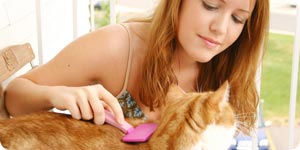
Cats are famously fastidious groomers. Anyone who’s lived with cats has observed them washing themselves several times a day; usually, they take care of themselves just fine.
Sometimes, however, you may wish to be involved. A grooming routine can be a good bonding experience; most cats enjoy the attention. Also, your cat may need help occasionally because of an unfortunate encounter with something icky, or you may have adopted a cat from difficult circumstances who just needs some help returning to his former elegance.
Before you get started, make sure you and your cat are both relaxed. If at all possible, enlist the help of a second person. Your helper can help Kitty stay still or just scratch him around the neck and ears to make it more enjoyable. This article covers the basics of grooming your cat; for more detailed information on this and other things you can do to care for your cat, I highly recommend the guide Ultimate Cat Secrets.
- If Kitty has mats: It’s a good idea to have a comb made especially for cats on hand; they’re metal with medium-sized teeth. In a pinch, you can use a comb made for people, as long as it’s not too fine-toothed. The key is in the technique.
Grasp the mat as close to Kitty’s skin as possible, or place your hand on him to minimize pulling. Start combing from the outside (farthest from the cat’s skin) and work your way in. You may need to work on it in installments—a little progress now, a little more later, as Kitty gets restless. If he becomes too distressed, you may need to cut the mats out.
If you must cut, use short, blunt scissors. Long scissors are too unwieldy, and sharp scissors raise the risk of nicking Kitty, leading to an infection (and a trip to the vet). A good choice is a pair of those small, inexpensive Fiskars® you can get at the supermarket. If you’re cutting mats around the neck or head area, have your helper keep Kitty’s ears safely out of the way. (He may turn his head suddenly to see what you’re doing.)
Grasp the mat as far down (as close to Kitty’s skin) as possible, and snip only what is above your fingers. If you can’t get to the bottom (if the mat is very close to the skin), just snip what you can and leave the rest. It may unravel itself, or you may be able to comb out the remainder. Or Kitty may take care of it himself.
- If Kitty has something really icky in his fur, especially in a spot he can’t easily reach: Rub some cornstarch in it. He probably won’t mind a bit; it’ll feel like a massage. The cornstarch will bind with anything dirty or greasy, and you can simply brush it out. If you don’t have a special cat brush, a gentle brush for people will do.
- If Kitty needs a bath: If he gets into something smelly or becomes flea-infested, a real bath might be necessary. Sometimes, a kitten in particular will have a tummy upset resulting in a mess too big for his grooming skills.
A sink is better than a bathtub because the smaller space makes him feel more secure: Put a rubber tub mat or a folded-up towel in the bottom for surer footing. Fill it to 3 or 4 inches of warm water. (Side note: More cats than you might think actually like playing in water. Most, however, don’t.)
A word of caution: Before using a spray device, make sure Kitty is comfortable with it. Many cats have an instinctive fear of hissing noises, and yours may go berserk. If the sprayer is a no-go, use a large plastic cup or pitcher. Get Kitty thoroughly wet, avoiding the head area. Do not get water in his ears.
Using a pet shampoo, lather Kitty thoroughly, but don’t overdo it, or you’ll be rinsing all day. Then rinse him thoroughly. This can’t be overstressed: Rinse Kitty thoroughly! If you don’t, Kitty may end up with a rash (and a trip to the vet). Now dry him with a towel (not a hair dryer—a towel) and allow him to groom himself to finesse the job. Grooming himself will help Kitty calm down.
If he’s a kitten, make sure you place him in a warm or sunny spot to finish drying; a kitten may not have the sense to move himself to such a spot and will shiver uncomfortably.
Occasionally, your cat may need to go to a professional groomer, and in extreme cases, may need to be sedated. If a professional grooming is called for, do it. A matted, filthy, greasy, flea-infested cat is a miserable one, and the problem isn’t going to go away by itself. But staying on top of grooming issues as they arise is the best way to ensure that they never get to that extreme.
